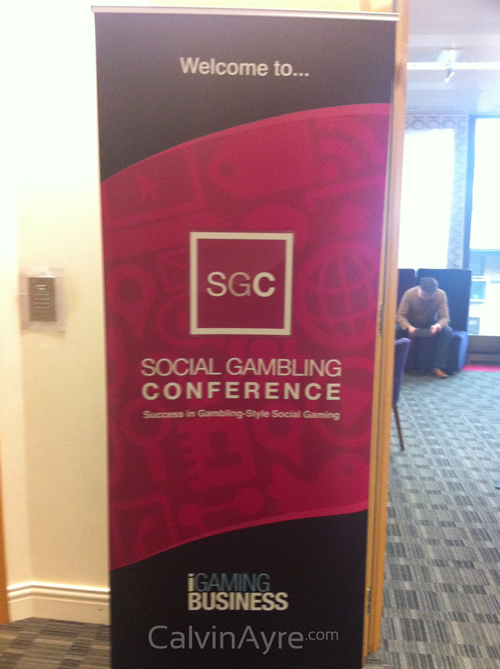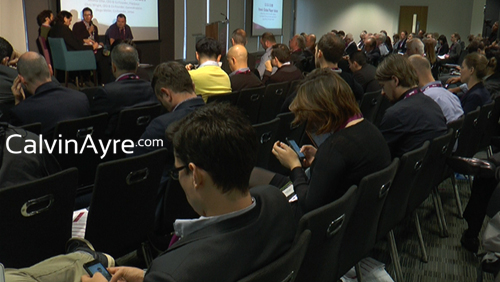 The second annual Social Gambling Conference kicked off today at the Dexter House in London, an event that has been extended to two days with a bit of a different focus than last year. The inaugural Social Gambling Conference 2012 covered how to enter the market and acquire players while this year is more focused on how to retain and monetize those players. Checkout the Social Gambling Conference Day 2 summary here.
The second annual Social Gambling Conference kicked off today at the Dexter House in London, an event that has been extended to two days with a bit of a different focus than last year. The inaugural Social Gambling Conference 2012 covered how to enter the market and acquire players while this year is more focused on how to retain and monetize those players. Checkout the Social Gambling Conference Day 2 summary here.
This year’s crowd hovered around the one hundred mark with representation from social gaming companies, payment companies, media, analysts and operators. Delegates enjoyed a full day of panels, sessions and networking breaks including the infamous “bento box” lunch.
The question of how much cross over truly exists between social gamers and real money gamblers continues to loom unanswered. There are several studies that have started coming out, for example the UK focused Kantor study, however the social gaming industry is new and there are a number of factors such as location, so the results are varied.
iGaming Consultant Jason Prasad completed his master’s thesis researching social gaming to real money gambling conversions, yet he was clear that his findings are “exploratory” and that further research is still needed. Despite the inevitable limitations of his findings, Prasad was able to determine that there three buckets of social gamblers:
1) Social gamers who are never going to play with real money
2) Social gamers who are open to real money gambling and have maybe tried it once or twice
3) Social gamers who already gamble with real money
Prasad’s thesis focused on social gamers who belong to category number two.
Throughout Prasad’s discussions with his twenty eight subjects from around the world, he concluded that social gamers’ behavior can be influenced positively or negatively by marketing communications. For example, word of mouth, celebrity endorsement, sports and event sponsorships, sexy girls…these are all triggers that have been successful in propelling a social gamer to real money gambling.
Moderator Michael Caselli summed it up nicely when he said, “You can convert, but you have to sell it right”.
Another interesting point made by Caselli is that in the United States online gambling is not (yet) readily available so players play on social gaming sites in the meantime. Therefore, once the US fully regulates online gambling, the expectation is that there will be a lot more cross over in the US in comparison to other markets such as the UK where online gambling has been regulated for years.
When it comes to monetization strategies, its important to take into account what geographical market you are after as they vary in acquisition cost. For example, in the big social gaming markets such as the United States and the UK, the CPA (cost per acquisition) will be higher as the competition for each social gamer is higher. Conversely, in smaller markets such as Latin America, the CPA will be much lower as there is less competition for each player, as pointed out by Vicenç Martí of Akamon Entertainment.
Diego Meller of Jampp added that all the “big fish” are driving up the CPA in the big markets, for example King.com and Zynga, so it makes it hard for the smaller companies to compete with the giants who have enormous budgets. The biggest opportunity for profitable growth in the social gaming market can be found in the smaller and less mature markets such as Africa and LatAm, he said.
There’s no doubt about it, LatAm is a region with some of the biggest growth opportunities for gaming and as Alfonso Villar of PlaySpace put it, “Brazil is the monster like China is in Asia”, so Brazil should most certainly be on the radar.
Something else that should be on the radar is activation techniques because the social gaming operator’s money comes from retention, not acquisition. Martí advised that all operators must understand the triggers for their players. “Awake sleeping players, reactivation is key”, he said.
Martí shared one of his trade secrets and advised that social gaming companies become experts on when people are getting paid in the country they are targeting. Is it weekly? Is it at the end of the month? Is it on the 31st, or more like the 26th as it is in Eastern European countries? Social gamers will snap up promos and spend more when they are paid. Its also important to keep in mind the times when your players will need a fix, such as Christmas night when they’re finished eating, fed up with the relatives and ready for some entertainment, he said.






